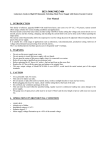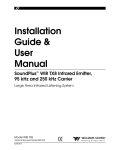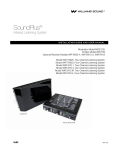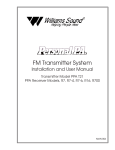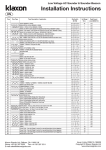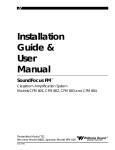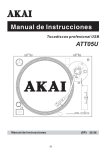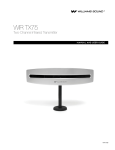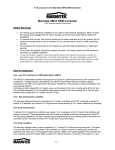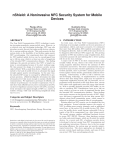Download Installation Guide & User Manual
Transcript
Installation Guide & User Manual SoundPlus® WIR TX300 Infrared System Large Area Infrared Listening System Modulator Model WIR MOD 1 Transmitter Model WIR TX3 Receiver Models WIR RX1, RX3, RX4 MAN 046C ® Williams Sound Helping People Hear SoundPlus® WIR TX300 Infrared Listening System Installation and User Manual Contents: Page Introduction 4 Controls and Features MOD 1 Front Panel MOD 1 Rear Panel TX3 Transmitter 5 5 6 Infrared Transmitter Setup Selecting a Transmitter Location Mounting TX3 Transmitter To Wall or Ceiling Transmitter Power Wiring 95 kHz Carrier Cable Connection 7 8 9 10 Modulator Installation Power Connection 95 kHz Carrier Cable Connection Audio Source Connection Using a Microphone Hi-Pass Filter Setting 10 11 11 11 11 Testing the System 12 Receiver Instructions 12 Battery Information 13 Suggestions For Receiver Management 14 Troubleshooting 14 Warranty 14 Specifications 15 Note: Taking a few minutes now to read these instructions will save time and ensure proper system operation. Williams Sound ® Helping People Hear 3 A single TX3 infrared transmitter will cover approximately 10,000 square feet of listening area. Larger areas can be covered with additional transmitters. The transmission is confined within opaque walls if security is an issue, such as courtrooms and corporate boardrooms. The Williams Sound Infrared System can also be used where multiple systems are needed in adjacent rooms, such as movie theaters and conference centers, without “spillover” from adjacent rooms. Introduction The Williams Sound WIR TX300 Infrared System consists of a MOD 1 Modulator and one or more TX3 Transmitters (also called emitters) which use invisible infrared (IR) light waves to broadcast speech or music to wireless infrared receivers. The Modulator accepts a variety of audio inputs and sends a 95 kHz frequency modulated signal to the Transmitter via a coaxial cable. The Transmitter emits invisible infrared light into the listening area. Infrared receivers detect the transmission and convert the light signals back into audio signals. The system is designed to broadcast high quality audio for hearing assistance and language translation applications. Because the system uses infrared light for transmission, it is not affected by interference from radio equipment and does not interfere with radio equipment. The system can be used with a microphone as a stand-alone system, or it can be connected to an existing sound system. Infrared Systems cannot be used in bright sunlight, which contains large amounts of interfering infrared light. Fig. 1: Typical System Configurations (1) Modulator and (1) Transmitter TX3 MOD 1 MOD 1 Infrared System Modulator Williams Sound I Power Audio Level Infrared Test Out Tape Out Mod Out 0 Ok Hi Williams Sound ® Helping People Hear + Adjust Mod In Power Supply (1) Modulator and (2) Transmitters Power Supply TX3 TX3 MOD 1 Williams Sound MOD 1 Infrared System Modulator I Power Audio Level Infrared Test Out Tape Out Mod Out 0 Ok Hi Mod In Power Supply Mod In Mod Out Power Supply Modulation Signal 4 Williams Sound ® Helping People Hear Williams Sound ® Helping People Hear + Adjust Power Supply Modulation Signal Williams Sound ® Helping People Hear Balanced Line-Level Input: Controls and Features: Female XLR jack for balanced, line-level inputs. Can also accept unbalanced input, and 4Ω, 8Ω, or 16Ω speaker line. MOD 1 Front Panel Power Switch: Turns modulator power on/off. 70V (Hi-Level) Input: Power Indicator: Female XLR jack for direct connection to a 70V or 25V speaker line. Green LED indicates power on. Input Level Switch: Audio Level Indicators: “Ok” amber LED indicates proper audio input level. “Hi” red LED indicates excessive audio input level. Three-position switch selects mic-level, line-level, or 70V input for the XLR input jack. Unbalanced Audio Inputs: Audio Level Control: Screwdriver rotary adjustment for audio input level. Infrared Test LED: Infrared LED provides a modulated IR signal for receiver testing, monitoring, audio source testing. Two RCA jacks for unbalanced line-level audio inputs. Inputs are mixed internally with the balanced input signal. High-Pass Filter: Three position switch provides 6dB/octave lowfrequency roll-off to reduce noise, improve speech intelligibility, compensate for typical high-frequency hearing loss. Tape Output: RCA Jack provides unbalanced, line-level audio output signal for tape recorders, etc. Modulator Outputs: MOD 1 Rear Panel Two F-type connectors provide 95 kHz frequency modulated outputs to feed two TX3 Transmitters. Balanced Microphone-Level Input: Female XLR jack for use with low impedance (150 200Ω) microphones. Supplies simplex DC power per DIN 45596 for condenser microphones. Power Input: Two-screw terminals for low-voltage power supply, 24VAC, 50 or 60Hz, 2.4VA. Fig. 2: MOD 1 Front & Rear Panels Williams Sound MOD 1 Infrared System Modulator I Infrared Test Out Audio Level Power Tape Out 0 Ok + Adjust Hi Model WIR MOD1 Infrared System Modulator Audio Input Balanced Audio Inputs Input Level Hi-Pass Filter Williams Sound ® Helping People Hear 75 Ohm 75 Ohm Power: 24 VAC, 50-60 Hz, 10VA 175 Hz 70V Right Plug 725 Hz 20 Hz Left Made in USA Modulator Out Unbalanced Line Mic Modulator Out 6dB/octave Williams Sound Corp. Power: 24 VAC, 60 Hz, 50VA 5 Fig. 3: TX3 Front & Rear Williams Sound ® Helping People Hear Infrared Transmitter Omnimount 25-STXMP Model WIR TX3 For Ceiling Mount Power Supply Wiring: Use NEC, Class 2 Wiring, 18 ga. Min 200 ft. Max. Length (18 ga.) Internal Fuse: 1.25 A, 250V, 3AG Modulation Signal Wiring: Omnimount 25-STXMP For Wall Mount Use RG59U Coax, 1000 ft. Max. Length CAUTION Note: It is normal for this unit to feel warm while it is in operation. Modulation Out (75 Ohm) RISK OF ELECTRIC SHOCK DO NOT OPEN WARNING: TO REDUCE THE RISK OF FIRE OR ELECTRIC SHOCK DO NOT EXPOSE THIS EQUIPMENT TO RAIN OR MOISTURE. Modulation In (75 Ohm) Williams Sound Corp., Minneapolis, Minnesota, USA Williams Sound Helping People Hear Made in U.S.A. ® TX3 Front TX3 Transmitter Power Input: Two–screw terminal strip for low-voltage power supply. 24VAC, 50 or 60Hz, 50VA. Each TX3 requires a separate power supply. Power Indicator LED (front panel): Located on the front panel in the center of the LED window. Red indicator light glows when power is on and the 95 kHz carrier is present. TX3 Rear Step 1: Infrared Transmitter Set-Up Selecting a Transmitter Mounting Location Rule 1: The Williams Sound Infrared System should not be installed outdoors or indoors where there is considerable direct sunlight. Sunlight generates infrared interference. Certain types of high-efficiency fluorescent lighting use 100kHz modulation that can also interfere with infrared systems. Rule 2: The most important principle to understand when installing an infrared system is that invisible infrared light behaves just like visible light. It does not pass through opaque objects like walls and curtains and people. It does pass through windows and door openings and it can bounce and scatter off reflective walls, floors, and ceilings. The IR transmitter panels cannot be concealed or covered up. The IR “eye” on the receiver unit cannot be covered up and works best with a clear line-of-sight to the transmitter panel(s). Rule 3: If you are not getting sufficient coverage with a properly installed transmitter panel, you need to add one or more additional transmitter panels. NOTE: The TX3 shuts off when no 95 kHz carrier is present. Modulation In: Connects to the Modulator Out jack of the MOD 1 modulator or another TX3 transmitter. Modulation Out: Connects to the Modulation In jack of of the next TX3 transmitter in the chain when multiple transmitters are used. Mounting Bracket: An omnidirectional mounting bracket is included with the Transmitter. Positions are indicated for wall and ceiling mounts. An optional tripod stand kit is also available (WSC Part #SS-2). 6 24 VAC Power In, 50-60 Hz, 35W Williams Sound ® Helping People Hear Figures 4, 5, and 6 illustrate infrared light patterns and recommended transmitter locations. In listening areas up to 10,000 square feet, the TX3 transmitter panel should be installed on the left or right side of the front wall of the listening area It needs to be above the audience to permit a direct line of sight between the transmitter and people wearing receivers when the people are standing or sitting. Fig. 4: Infrared Illumination Pattern 250 ft. 130 ft. 25° 25° TX3 It’s helpful to think of the IR transmitter as an invisible floodlight. You want to aim it so listeners are “flooded” with infrared light. Many listening areas will require two IR transmitters for complete coverage. Place one transmitter panel on the left side of the front wall and the other on the right hand side. The two transmitters will be connected together with a coaxial cable. The infrared illumination pattern from a single transmitter is a cone-shaped beam, with a 50° angle. The horizontal and vertical patterns are identical. Figures 4 and 5 show examples of coverage patterns. Fig. 5: Maximizing Coverage These patterns are the direct radiation pattern. The infrared radiation does not drop to zero outside the illustrated patterns; it decreases. It still may be useable at a greater distance, depending on receiver sensitivity and reflection characteristics of the room. Top Perspective Infrared light reflects off light-colored surfaces and scatters, which increases the coverage area. Dark colored surfaces tend to absorb infrared light, minimizing reflections, and limiting coverage to the direct illumination pattern. It’s O.K. (and desirable) for the illumination patterns to overlap when Using Two Transmitters For Greater Coverage Area Fig. 6: Side Perspective 120' Center ter Bea Of Emit m 30' SCREEN 6' STAGE Williams Sound ® Helping People Hear 7 multiple transmitters are used. Placing the transmitter high above the audience (15 to 30 feet) and aimed slightly downward (5 to 15°) will ensure the longest “throw” of the infrared beam. Angling the transmitter inward towards the center of the room also increases the coverage of the seating area. Remember that opaque objects block the infrared light. Thus, transmitters cannot be concealed behind an opaque walls, curtains, etc. Neither should transmitters be used in areas of extreme high or low temperatures, humidity, or chemical environments. Fig. 7: SB-3 Wall/Ceiling Mount Mounting Plate Clamp Plate To Wall Or Ceiling Use the 5/32" allen wrench to loosen the tension bolt in the clamp assembly enough to release the ball. DO NOT unscrew the tension bolt completely. Using the mounting plate as a template, mark the hole locations on the mounting surface. Use fasteners appropriate for the mounting surface (wood screws, lag bolt, wall anchor) to attach the mounting plate. Recommended fastener size is 1/4". Step 2: Attach the clamp plate to the rear of the transmitter, using (2) 1/4 x 20 x 1/2" socket head screws and 3/16 hex wrench provided. Place the mounting plate in the position indicated for ceiling or wall mounting. Step 3: Place the transmitter/clamp plate assembly onto the the mounting plate ballshaft. Aim the transmitter at the desired downward angle and support it fully while using the hex wrench to tighten the tension screw. After initial installation, the ball will slowly compress under pressure. Check the tension screw after 15 minutes and retighten if necessary. DO NOT overtighten. If rotational adjustment is required, use a 7/16" open-end wrench to loosen the jam nut on the ballshaft. Rotate the transmitter and re-tighten the jam nut. 8 To Transmitter Jaw Mounting the TX3 to a wall or ceiling: Step 1: Ballshaft Tension Screw Fig. 8: Bracket 012 Ceiling Mounting Fig. 9: Bracket 012 Wall Mounting Jam Nut Front of TX3 Williams Sound ® Helping People Hear spade terminals supplied. Connect one end of the zipcord to the transmitter power input screw terminals. Connect the other end to the power supply screw terminals. Step 2: Transmitter Power Wiring WARNING! BE SURE AC POWER IS TURNED OFF AT THE OUTLET WHILE INSTALLING THE POWER TRANSFORMER. A METAL COVER PLATE COULD SLIP AND SHORT ACROSS THE TRANSFORMER PLUG DURING INSTALLATION, CREATING A SHOCK HAZARD. Step 2: SHORTING THE POWER SUPPLY TERMINALS WILL BLOW A NON-REPLACEABLE INTERNAL FUSE, DESTROYING THE POWER SUPPLY UNIT1 Make sure to.switch AC power to the outlet OFF at the fuse or circuit breaker. Remove the wallplate cover screw and plug the transformer into the outlet. Secure the transformer with the cover plate screw. Turn the AC power back on at the breaker box AFTER the transformer is installed. The indicator light on the front panel of the TX3 will not glow unless there is a 95 kHz carrier. This auto shut-off feature preserves the life of the IR LED’s and reduces power consumption when the transmitter is not in use. The wall transformer can be plugged into a switched outlet that turns on when the other sound equipment is turned on. This system is designed for Class 2, low-voltage wiring. Always follow local electrical codes when doing low voltage wiring. The TX3 transmitter is supplied with a low-voltage wall transformer power supply. The transmitter must be located within 6 feet of an AC wall outlet or the 24 Volt power cord must be extended. Additional two-conductor, 18 ga. zipcord is included with the transmitter. If the transmitter power supply can be located near the modulator, use the combination cable to carry the modulation signal and low-voltage power to the transmitter. The zipcord can be separated from® the combination cable if the power Williams Sound Infrared Transmitter Omnimount Helping People Hear 25-STXMP supply is located near the transmitter. Model WIR TX3 For Ceiling Mount DO NOT CONNECT THE POWER SUPPLY TO AC POWER YET!!! Step 1: Determine the length of zipcord needed to from the transmitter to the AC wall Use NEC, Class 2 Wiring, 18 ga. Min outlet where the power supply will be 200 ft. Max. Length (18 ga.) Omnimount plugged in. Cut the zipcord to length. Internal Fuse: 25-STXMP 1.25 A, 250V, 3AG Zipcord length For must not exceed 200 feet. Wall Mount Modulation Signal Wiring: Use RG59U Coax, Strip the ends and install the crimp-on Power Supply Wiring: reach 1000 ft. Max. Length CAUTION Note: It is normal for this unit to feel warm while it is in operation. Modulation Out (75 Ohm) Fig. 10: TX3 Wiring Detail RISK OF ELECTRIC SHOCK DO NOT OPEN WARNING: TO REDUCE THE RISK OF FIRE OR ELECTRIC SHOCK DO NOT EXPOSE THIS EQUIPMENT TO RAIN OR MOISTURE. Modulation In (75 Ohm) Williams Sound Corp., Minneapolis, Minnesota, USA 24 VAC Power In, 50-60 Hz, 35W Made in U.S.A. Baseband Output Connection Power Connection Connect to MOD 1 here using RG-59 cable. Plug in Power Supply Williams Sound ® Helping People Hear 9 Step 3: Step 3: 95 kHz Carrier Cable Installation Step 1: Determine the length of RG59 coaxial cable needed to reach from the transmitter to the modulator unit. The modulator is usually located near the other sound equipment to simplify audio connections. 100 feet of coaxial cable is included with each transmitter. You will need to cut it to length and install F-connectors on both ends. Additional RG59 coax can be added, up to 1000 feet maximum. Make sure you leave some slack at each end. Step 2: Install the F-connectors on each end of the cable. You will need a CATV-type coax stripper and crimper. Step 3: Connect the 95 kHz carrier cable to either Modulator Out jack on the MOD 1 modulator and to the Modulator In jack on the TX3 transmitter. Connect the modulation cable from the Modulation Out Jack on the first transmitter in the chain (the one connected to the MOD 1 Modulator) to the Modulation In jack on the next TX3 transmitter in the chain. Use the cable clamps and screws provided to secure the cable. The coax can also be routed through conduit. You can chain as many transmitters together as you need. Remember that each transmitter needs its own power supply. If you are using more than one transmitter: Step 1: Determine the length of coaxial cable needed to reach between the transmitters. 100 feet of coaxial cable is included with each transmitter. You will need to cut it to length and install F-connectors on both ends. Additional RG59 coax can be added, up to 1000 feet maximum. Make sure you leave some slack at each end. Step 2: Install the F-connectors on each end of the cable. You will need a CATV-type coax stripper and crimper. Fig. 11: Modulator Wiring Detail Model WIR MOD1 Infrared System Modulator Audio Input Balanced Audio Inputs Input Level Hi-Pass Filter Line Mic Modulator Out Power: 24 VAC, 50-60 Hz, 10VA 175 Hz 70V Left Right Plug 725 Hz 20 Hz Made in USA 10 Modulator Out Unbalanced 6dB/octave Williams Sound Corp. 75 Ohm 75 Ohm Power: 24 VAC, 60 Hz, 50VA Baseband Output Connection Power Connection Connect to TX3 here using RG-59 cable. Plug in Power Supply Williams Sound ® Helping People Hear Step 4: MOD 1 Modulator Installation Location: The Modulator is usually located near the sound system amplifier or mixer for easy access to an audio input signal. For portable systems, the modulator can be placed near the transmitter or wherever is most convenient. Power Connection Step 1: Connect the power supply wires to the two center screw terminals on the terminal block located on the rear of the Modulator. Step 2: Plug the power supply into an AC outlet. 95 kHz Cable Connection Connect the coaxial cable to either F-type “Modulator Out” jack on the MOD 1. For systems having multiple transmitters, both modulator outputs can be used to run a separate coax cable to transmitters on each side of a stage, screen, etc. The MOD 1 drives one transmitter per modulator output. The transmitters then repeat the 95 kHz signal, so any number of transmitters can be used. The modulator outputs CANNOT be split with CATV splitters. Audio Connection Mono, Unbalanced Source: Use the RCA to RCA audio cable supplied to connect either MOD 1 unbalanced “Audio Input” jack to an appropriate unbalanced, line-level audio output jack on the sound system mixer or amplifier. Suitable connections are: 1st Choice: TAPE OUT or LINE OUT Jack 2nd Choice: BOOSTER or BRIDGING Jack If your amplifier or mixer does not have RCA-type connectors, you can obtain adaptors from your Williams Sound Authorized Dealer or a local radio parts store. If the TAPE OUT jack is already in use, a Y-Cord can be used to connect the MOD 1 and a second device to the same jack. Williams Sound ® Helping People Hear Stereo, Unbalanced Source: For stereo sources, use an additional RCA to RCA cable and connect the left and right signals to the two inputs on the MOD 1. They will be mixed into a mono signal for transmission. Three–Channel, Unbalanced Source (Left, Right, Center Channel): Set the input level switch to “Line.” Use the two unbalanced inputs and the XLR balanced input. You will have to make an RCA to XLR adaptor cable. To unbalance the XLR input, wire XLR pin 2 to the positive audio pin on the RCA plug and wire XLR pin 1 and pin 3 together to the audio ground sleeve on the RCA plug. The three signals will be mixed into a mono signal for transmission. Balanced, Line–Level Source: Set the Input Level Switch to “Line.” The XLR input jack can be connected to any balanced, line-level audio signal. It has an input impedance of 100 KOhms, so it will not load the signal. Balanced, Microphone Source: Set the Input Level switch to “Mic.” Any lowimpedance, balanced microphone can be plugged into the XLR input jack. Simplex power is supplied for condenser microphones. 4 or 8 Ohm Speaker Line Source: Set the Input Level Switch to “Line.” Wire an adaptor cable with the positive speaker line connected to XLR pin 2. Connect the negative or ground speaker line to XLR pin 3. 25 or 70V Speaker Line Source: Set the Input Level Switch to “70V.” Wire an adaptor cable with the positive speaker line connected to XLR pin 2. Connect the negative or ground speaker line to XLR pin 3. Hi-Pass Filter Setting The normal setting is the center (175Hz) position. For language interpretation or visual description, the 20Hz setting can be used. For hearing assistance, the 725Hz setting can be used to compensate for typical high-frequency hearing loss. Ask the users what sounds best to them. 11 Step 5: Testing the System Step 1: Step 2: After the 95 kHz carrier cable, power cables, and audio source are connected, turn the MOD 1 power switch on. The green LED on the front of the MOD 1 should light. Make sure the sound system is on and your audio source is active. Adjust the Audio Level control on the front of the MOD 1 until the “OK” light flashes with the audio signal. It is okay if the red “Hi” light flashes occasionally, but it should not stay lit constantly. If you can't get the “Ok” light to come on, make sure the Input Level switch is set properly. If it is, you need to boost the signal source. Receiver Operating Instructions Receiver Model WIR RX1 The RX1 is a stethoscope-style receiver with built-in earphones. Make sure the “eye” on the front of the receiver is not covered up when in use. The receiver is intended to be worn on the front of the body, hanging from the ears. Step 1: Battery Installation: The RX1 uses two AAA Alkaline batteries. To insert, remove the cover, press the batteries into place,then replace the cover. Step 2: Turn the power on by rotating the volume control. Continue rotating until a comfortable volume level is reached. To avoid draining the battery, make sure the receiver is turned off when not in use. Step 3: Look at the transmitter panel(s). With the modulation signal and power connected, a red light should be visible in the center of the panel. Step 4: Hold a receiver near the “Infrared Test Out” hole on the front of the MOD 1. Turn the receiver on and adjust the volume. You should be able to hear the audio signal through the receiver. If not, make sure the audio “Ok” light is still flashing. If the light is not flashing, check your audio source or the setting of the input level switch and input level control. If the audio light is flashing, but you don’t hear anything from the receiver, try a different receiver to make sure the receiver is working. Make sure the “eye” on the front of the receiver is not covered up when in use. The receiver is intended to be worn on the front of the body, hanging from the lanyard attached to the receiver. The receiver will not work if it is placed in a pocket or purse. A variety of earphones, headphones, or a neckloop telecoil coupler can be used with the RX3 Receiver. Step 1: Battery Installation: Open the battery compartment by lifting the tab at the bottom of the receiver. Press the battery into place, observing proper battery polarity. Take a receiver into the listening area and walk around to check the reception. Make sure the “eye” on the receiver is not covered up when in use. The receiver will not work if it is placed in a pocket or purse. The receiver eye must be able to “see” the transmitter panel. It may be necessary to adjust the angle of the transmitter(s) to obtain the best coverage. If coverage is not adequate, additional transmitter panels must be used. Step 2: Plug the earphone or headphone into the earphone jack. Step 3: Turn the receiver on by rotating the volume control in the direction of the arrow on top of the case. Turning the knob in the direction of the arrow will increase the volume. Turning the knob against the arrow will decrease the volume. To avoid draining the battery, make sure the receiver is turned off when not in use. Step 5: 12 Receiver Model WIR RX3 Williams Sound ® Helping People Hear Receiver Model WIR RX4 The RX4 is a headset-style receiver. Make sure the “eye” on top of the receiver is not covered up when in use. Step 1: Step 2: Battery Installation: Open the battery compartment by sliding the battery door open on the earpiece. Press two AAA batteries into place, observing proper battery polarity. Slide the battery door closed, taking care not to crush the plastic locking tabs. Turn the power switch on top of the receiver on. Adjust the volume control wheel located on the bottom of the headset. leaving the receiver on for several hours and then immediately recharge it. Receivers can be left charging continuously when not in use. DO NOT ATTEMPT TO RECHARGE DISPOSABLE BATTERIES! AVOID SHORTING PLUS AND MINUS BATTERY TERMINALS TOGETHER WITH METAL OBJECTS. BATTERY DAMAGE AND BURNS CAN RESULT! DO NOT MIX RECHARGEABLE BATTERIES & CHARGERS FROM DIFFERENT MANUFACTURERS. Battery Information for Receivers For the RX3 Receiver in normal use, a heavy-duty 9 Volt battery such as the Eveready 216 will last about 10 hours. Alkaline batteries such as the Eveready 522 will provide about 17 hours of use. For the RX4, alkaline AAA batteries will last about 20 hours. If the sound becomes weak or distorted, replace the battery. The indicator light may still be on, even with a battery that is weak. Do not leave dead batteries in the receivers, they may leak and damage the receiver. Rechargeable Batteries: The RX3 receivers can also use a rechargeable battery. We recommend only the 7-cell, 8.4 Volt types (BAT 003). A fully-charged battery (Williams BAT 003) will provide about 5 hours of use per charge. The battery may be recharged without removing it from the receiver. The BAT 005 Single Charger has a cord that plugs into the receiver “EAR” jack to charge the battery. The CHG 1269 Multiple Charger can charge 12 receivers simultaneously through the receiver “EAR” jacks. The receiver should always be turned OFF while charging. It takes about 14 hours to fully charge the battery. If the battery is providing very short service life (under 1 hour of use) let it drain completely by Williams Sound ® Helping People Hear 13 Suggestions for Receiver Management: Different types of facilities will use different approaches for receiver management and earphone sanitation. Following are some alternatives that other customers have used successfully: 1. Regular users purchase their own receiver and take care of their own batteries and earphone. 2. Some facilities label the receiver and earphone with the names of regular users so each person uses the same receiver and earphone. 3. Ushers issue receivers to people who request them. Earphones are sanitized after use. Foam ear cushions can be replaced or washed with a mild detergent, rinsed thoroughly and airdried. The EAR 022 Surround Earphone can be sanitized with an alcohol pad. 4. The receivers are stored in a multiple compartment storage case with a credit card or driver's license left as collateral for the receiver. 5. Regular users purchase their own earphone or headphone and bring them to use with receivers at the facility. 2. If none of the receivers work, check to see if the power and 95 kHz carrier cable are connected to the transmitter and the “Power” like is ON. 3. Check to see if the modulator is connected properly to the sound system. The audio level lights should be flashing on the modulator. 4. Make sure the “eye” is not covered up on the receiver. There must be clear line of sight between the receiver eye and the transmitter panel. Sound through the receivers is weak and noisy. 1. Hold a receiver in front of the Infrared Test LED on the front of the MOD 1 modulator and listen to the signal. If the signal is weak and noisy here, check the Input Level switch and Input Level Control settings. Increase the input signal level from the sound system by turning up a mixer control. If the signal sounds okay, you may need to re-position the transmitter panels or add additional panels. Buzzing or humming noise in sound system. 1. Check for ground loops or noise on the input signal. Call your Authorized Dealer or Williams Sound for help. Troubleshooting: Transmitter “Power” light not on. 1. Make sure the wall transformer is plugged into the transmitter and the power switch or any remote power switch is on.. 2. Make sure the electrical outlet is on. 3. Make sure the MOD1 is on. The TX3 shuts off when there is no 95kHz modulation signal. 4. Make sure the 24VAC power supplies are working. No sound through receivers. 1. 14 If some of the receivers work but others don’t, check for bad batteries or earphones on the receivers that aren’t working. Warranty Williams Sound Transmitters and Receivers are warranted against defects in workmanship and materials for FIVE YEARS. Microphones, earphones, cables, carry cases, rechargeable batteries and chargers are warranted against defects in workmanship and materials for 90 DAYS. This warranty does not extend to intentional or accidental physical damage. This warranty applies only to products returned to Williams Sound for service. To return a product for service, call Williams Sound Corp. at 1-800-843-3544 and request a Return Authorization (RA) number. Williams Sound ® Helping People Hear SoundPlus™ WIR TX300 Infrared Listening System Specifications Infrared Audio Processor/Modulator, Model MOD 1 Dimensions, Weight: Color: Rack Mount: Power: Modulation: AGC: Operating Req.: 8.45" (21.5 cm) W x 8.18" (20.8 cm) D x 1.72" (4.4 cm) H, 3 lbs. (1.5 kg) Black epoxy paint with white legends One IEC rack space high, one or two units can be mounted in a single rack space with optional RPK 005 (single) or RPK 006 (double) Rack Mount Kits External power supply, 24VAC, 50 or 60Hz, 2.4VA, 82mA max. current drain 95kHz FM, ± 15kHz deviation, 75Ω source impedance, 75µsec pre-emphasis, Variable slope compressor/limiter 0-50°C ambient temperature, noncondensing, non-corrosive atmosphere Front Panel: Power Switch: Power Indicator: Audio Indicators: Two-position rocker, ON/OFF Green LED Amber LED "Ok" for nominal input signal level Red LED "Hi" for excessive input signal level Audio Level Control: Rotary pot, screwdriver adjust, used with audio indicator lights Tape Output: RCA jack, 600mV, 1200Ω source impedance, 10KΩ nominal load impedance Infrared Test LED: IR LED for receiver testing, monitoring, and audio signal testing Rear Panel: Audio Inputs: All three inputs are actively mixed into a single signal, allowing use of mono, stereo, or 3 channel audio sources Balanced Audio In: 3-pin female XLR, accepts microphone, line, 25V or 70V audio input Mic Input: lo-Z, 100µV min. to 50mV max. 1mV nominal, 3kΩ input impedance Supplies simplex power 20V (DIN45296) for condenser mics Line Input: 21mV min. to 10V max., 212mV nominal, 100KΩ input impedance 70 Volt Input: 216mV min. to 100V max., 2.16V nominal, 100KΩ input impedance Unbalanced Audio Ins: (2) RCA, 21mV min. to 10V max., 212mV nominal, 50KΩ input impedance Input Selector: 3-position slide-type switch, selects: mic/line/70V on balanced audio input High-Pass Filter: 3-position slide-type switch, 20Hz, 175Hz, or 725Hz, 6dB/octave roll-off Modulation Outputs: (2) F-type connectors, 75Ω, 95kHz FM, ±15kHz deviation, 0.5V P-P signal uses RG-59 cable, 1000 ft. (304 m) max. CATV splitters cannot be used Power Connections: 2-conductor, screw-terminals Transmitter Type: For use with Williams Sound WIR TX1, WIR TX2, WIR TX3 Transmitter/Emitter panels. Each MOD 1 Modulator can drive two Transmitter panels directly. For multitransmitter systems, each TX3 repeats the modulation signal to drive the next transmitter in the chain. Infrared Transmitter, Model TX3 Dimensions, Weight: Color: Wall Mount: Tripod Mount: Power: Operating Req.: Coverage Area: 11.125" (28.3 cm) W x 8.125" (20.6 cm) H x 3.25" (8.3 cm) D, 3.25 lbs. (1.6 kg) Black epoxy paint with white legends, red acrylic window Omnidirectional mount included for wall and ceiling mounting. Optional SS-2 Tripod Stand Kit available External power supply, 24VAC, 50 or 60Hz, 50VA, 0.9A nom. current drain Transmitter shuts off when modulation signal is not present 0-50° C ambient temperature, noncondensing, non-corrosive atmosphere 10,000 sq. ft. (930 sq. m), 50° cone pattern, see coverage diagram Williams Sound ® Helping People Hear TX3 Front Panel: Power Indicator: Red LED, visible in center of window, also indicates 95 kHz signal is present TX3 Rear Panel: Mounting Holes: Modulation Input: Modulation Output: Power Connection: 95 kHz Carrier Cable: Power Cable: Two sets of threaded holes for use with omnidirectional mount (included) two threaded holes on sides of the cabinet for Tripod Stand Kit F-type connector, 75Ω, 95kHz FM, 0.5V P-P signal from MOD 1 Modulator F-type connector, 75Ω, 95kHz FM, 0.5V P-P signal output to additional TX3 2-conductor, screw-terminals RG-59 Coax, F-connectors NEC Class 2 wiring, 2-conductor, 18 ga. min., 200 foot (61 m) max. length (for 18 ga. wire), each TX3 Transmitter requires its own 24VAC Power Supply. 15 Williams Sound Corp. 10321 West 70th St., Eden Prairie, MN 55344-3446 U.S.A. 800-843-3544 / 952-943-2252 / FAX: 952-943-2174 © 1996, Williams Sound Corp. MAN 046C
















